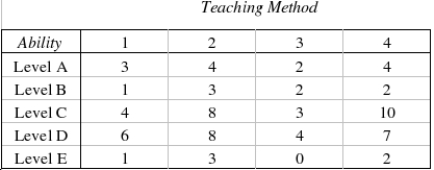Asked by Cameon Viney on Jul 28, 2024

Verified
Another school district also planned to evaluate two different workbooks and two distinct teaching machines to assess their effectiveness in teaching the concept of multiplication. However, the administrators in this school district consulted a statistician about the design of their study. Because they were looking for a method effective on children of all abilities, the statistician suggested they check the children's past scholastic records and divide the children into groups according to their ability level. These ability groups represent relatively homogeneous experimental units within which the comparison of teaching methods may be made. She assigned one child from each ability level to each teaching method. Twenty students participated in the study. After receiving instruction, the children took a multiplication test and the number of errors they made were recorded.  What experimental design did the statistician use?
What experimental design did the statistician use?
________________________________________________________
The null and alternate hypotheses are as follows:  : The three population distributions are identical.
: The three population distributions are identical.  : At least two of the three population distributions differ in location.
: At least two of the three population distributions differ in location.
Describe what the test statistic  is.
is.
________________________________________________________
Test Statistic:  = ______________
= ______________
Reject Region:
Reject  if F > ______________
if F > ______________
Conclude: ______________
The teaching methods ______________ equally effective.
Estimate the observed significance level of this test.
______________
Experimental Design
A plan for conducting an experiment to ensure that it can test hypotheses effectively while minimising errors or bias.
Teaching Methods
Various strategies, techniques, and approaches employed by teachers to facilitate student learning and understanding.
Ability Level
A measure of a person's competency or skill set in a particular area.
- Comprehend the methods of constructing and evaluating hypotheses to analyze correlations or variances among groups.
- Acquire knowledge on how to interpret and assess the ramifications of testing data in real-life contexts or study environments.
- Gain an understanding of the fundamentals of a randomized block design and how it is applied in nonparametric testing scenarios.

Verified Answer

Learning Objectives
- Comprehend the methods of constructing and evaluating hypotheses to analyze correlations or variances among groups.
- Acquire knowledge on how to interpret and assess the ramifications of testing data in real-life contexts or study environments.
- Gain an understanding of the fundamentals of a randomized block design and how it is applied in nonparametric testing scenarios.
Related questions
A Professor Was Interested in the Relationship Between a Student's ...
A Study Was Conducted to Compare Automobile Gasoline Mileage for ...
In a Randomized Block Design of ANOVA, How Many Factors ...
_____Provide(s) Context for Your Scores on a Particular Psychological Instrument ...
Dawn Took the Narcissistic Personality Inventory (NPI) and Scored a ...